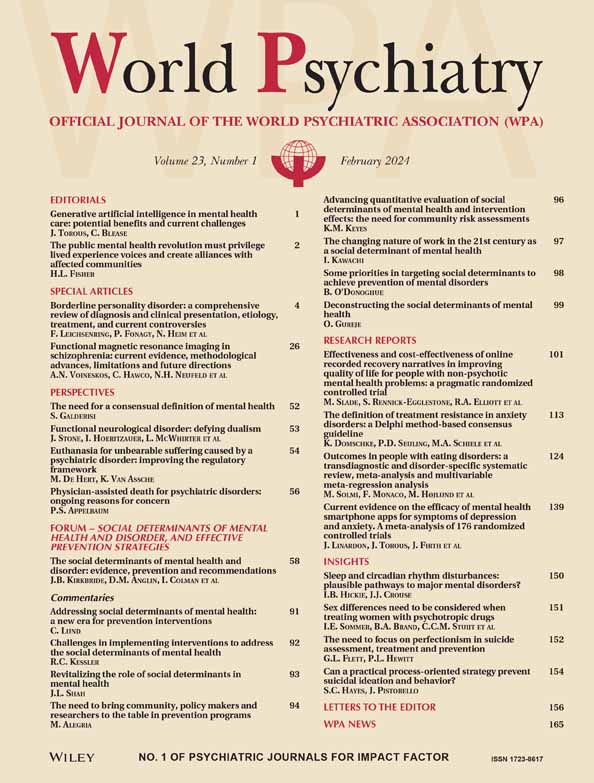Ultra high risk status and transition to psychosis in 22q11.2 deletion syndrome
IF 65.8
1区 医学
Q1 PSYCHIATRY
引用次数: 52
Abstract
The 22q11.2 deletion syndrome (22q11DS) is characterized by high rates of psychotic symptoms and schizophrenia, making this condition a promising human model for studying risk factors for psychosis. We explored the predictive value of ultra high risk (UHR) criteria in a sample of patients with 22q11DS. We also examined the additional contribution of socio‐demographic, clinical and cognitive variables to predict transition to psychosis within a mean interval of 32.5 ± 17.6 months after initial assessment. Eighty‐nine participants with 22q11DS (age range: 8‐30 years; mean 16.1 ± 4.7) were assessed using the Structured Interview for Psychosis‐Risk Syndromes. Information on Axis I diagnoses, internalizing and externalizing symptoms, level of functioning and IQ was also collected. At baseline, 22 (24.7%) participants met UHR criteria. Compared to those without a UHR condition, they had a significantly lower functioning, more frequent anxiety disorders, and more severe psychopathology. Transition rate to psychosis was 27.3% in UHR and 4.5% in non‐UHR participants. Cox regression analyses revealed that UHR status significantly predicted conversion to psychosis. Baseline level of functioning was the only other additional predictor. This is the first study investigating the predictive value of UHR criteria in 22q11DS. It indicates that the clinical path leading to psychosis is broadly comparable to that observed in other clinical high‐risk samples. Nevertheless, the relatively high transition rate in non‐UHR individuals suggests that other risk markers should be explored in this population. The role of low functioning as a predictor of transition to psychosis should also be investigated more in depth.22q11.2缺失综合征的超高风险状态和向精神病的过渡
22q11.2缺失综合征(22q11DS)的特点是精神病症状和精神分裂症的高发率,使其成为研究精神病危险因素的有希望的人类模型。我们探讨了超高风险(UHR)标准在22q11DS患者样本中的预测价值。我们还检查了社会人口统计学、临床和认知变量对预测在初始评估后平均32.5±17.6个月的时间间隔内转变为精神病的额外贡献。89名22q11DS患者(年龄范围:8 - 30岁;平均16.1±4.7),采用精神疾病危险综合征结构化访谈进行评估。还收集了I轴诊断、内化和外化症状、功能水平和智商的信息。基线时,22名(24.7%)参与者符合UHR标准。与没有UHR症状的人相比,他们的功能明显较低,焦虑症更频繁,精神病理更严重。UHR参与者向精神病的转换率为27.3%,非UHR参与者为4.5%。Cox回归分析显示,UHR状态显著预测转化为精神病。基线功能水平是唯一的其他附加预测指标。这是第一个调查22q11DS中UHR标准预测价值的研究。这表明导致精神病的临床路径与在其他临床高风险样本中观察到的大致相当。然而,非UHR个体中相对较高的转换率表明,应该在这一人群中探索其他风险标记。低功能作为向精神病过渡的预测因子的作用也应该进行更深入的研究。
本文章由计算机程序翻译,如有差异,请以英文原文为准。
求助全文
约1分钟内获得全文
求助全文
来源期刊

World Psychiatry
医学-精神病学
自引率
7.40%
发文量
124
期刊介绍:
World Psychiatry is the official journal of the World Psychiatric Association. It is published in three issues per year.
The journal is sent free of charge to psychiatrists whose names and addresses are provided by WPA member societies and sections.
World Psychiatry is also freely accessible on Wiley Online Library and PubMed Central.
The main aim of World Psychiatry is to disseminate information on significant clinical, service, and research developments in the mental health field.
The journal aims to use a language that can be understood by the majority of mental health professionals worldwide.
 求助内容:
求助内容: 应助结果提醒方式:
应助结果提醒方式:


